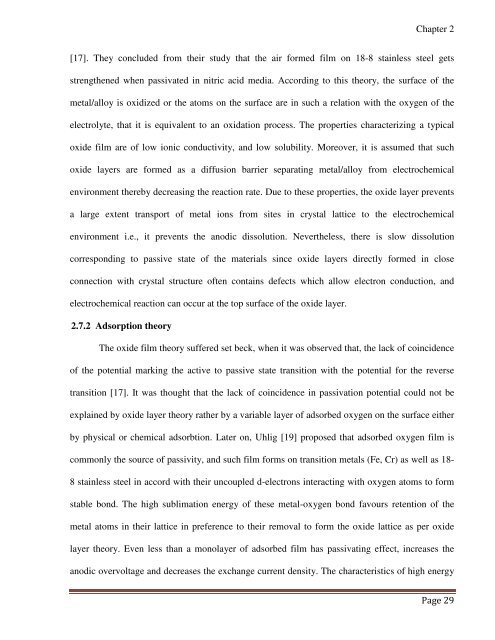CHEM02200704003 Nilamadhab Pandhy - Homi Bhabha National ...
CHEM02200704003 Nilamadhab Pandhy - Homi Bhabha National ...
CHEM02200704003 Nilamadhab Pandhy - Homi Bhabha National ...
You also want an ePaper? Increase the reach of your titles
YUMPU automatically turns print PDFs into web optimized ePapers that Google loves.
Chapter 2<br />
[17]. They concluded from their study that the air formed film on 18-8 stainless steel gets<br />
strengthened when passivated in nitric acid media. According to this theory, the surface of the<br />
metal/alloy is oxidized or the atoms on the surface are in such a relation with the oxygen of the<br />
electrolyte, that it is equivalent to an oxidation process. The properties characterizing a typical<br />
oxide film are of low ionic conductivity, and low solubility. Moreover, it is assumed that such<br />
oxide layers are formed as a diffusion barrier separating metal/alloy from electrochemical<br />
environment thereby decreasing the reaction rate. Due to these properties, the oxide layer prevents<br />
a large extent transport of metal ions from sites in crystal lattice to the electrochemical<br />
environment i.e., it prevents the anodic dissolution. Nevertheless, there is slow dissolution<br />
corresponding to passive state of the materials since oxide layers directly formed in close<br />
connection with crystal structure often contains defects which allow electron conduction, and<br />
electrochemical reaction can occur at the top surface of the oxide layer.<br />
2.7.2 Adsorption theory<br />
The oxide film theory suffered set beck, when it was observed that, the lack of coincidence<br />
of the potential marking the active to passive state transition with the potential for the reverse<br />
transition [17]. It was thought that the lack of coincidence in passivation potential could not be<br />
explained by oxide layer theory rather by a variable layer of adsorbed oxygen on the surface either<br />
by physical or chemical adsorbtion. Later on, Uhlig [19] proposed that adsorbed oxygen film is<br />
commonly the source of passivity, and such film forms on transition metals (Fe, Cr) as well as 18-<br />
8 stainless steel in accord with their uncoupled d-electrons interacting with oxygen atoms to form<br />
stable bond. The high sublimation energy of these metal-oxygen bond favours retention of the<br />
metal atoms in their lattice in preference to their removal to form the oxide lattice as per oxide<br />
layer theory. Even less than a monolayer of adsorbed film has passivating effect, increases the<br />
anodic overvoltage and decreases the exchange current density. The characteristics of high energy
















